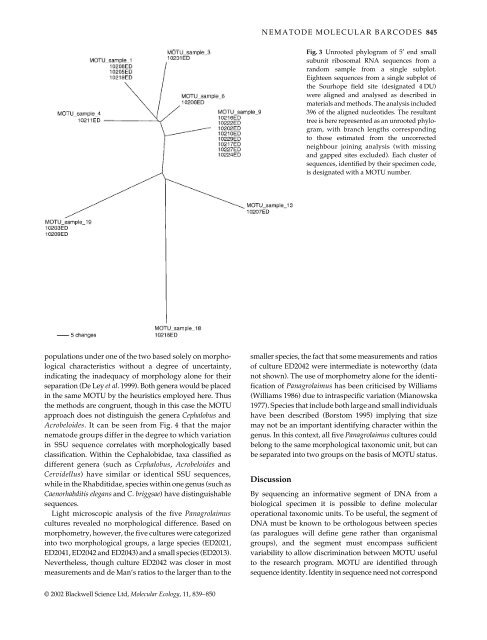Molecular barcodes for soil nematode identification - Bolinfonet.org
Molecular barcodes for soil nematode identification - Bolinfonet.org
Molecular barcodes for soil nematode identification - Bolinfonet.org
Create successful ePaper yourself
Turn your PDF publications into a flip-book with our unique Google optimized e-Paper software.
populations under one of the two based solely on morphological<br />
characteristics without a degree of uncertainty,<br />
indicating the inadequacy of morphology alone <strong>for</strong> their<br />
separation (De Ley et al. 1999). Both genera would be placed<br />
in the same MOTU by the heuristics employed here. Thus<br />
the methods are congruent, though in this case the MOTU<br />
approach does not distinguish the genera Cephalobus and<br />
Acrobeloides. It can be seen from Fig. 4 that the major<br />
<strong>nematode</strong> groups differ in the degree to which variation<br />
in SSU sequence correlates with morphologically based<br />
classification. Within the Cephalobidae, taxa classified as<br />
different genera (such as Cephalobus, Acrobeloides and<br />
Cervidellus) have similar or identical SSU sequences,<br />
while in the Rhabditidae, species within one genus (such as<br />
Caenorhabditis elegans and C. briggsae) have distinguishable<br />
sequences.<br />
Light microscopic analysis of the five Panagrolaimus<br />
cultures revealed no morphological difference. Based on<br />
morphometry, however, the five cultures were categorized<br />
into two morphological groups, a large species (ED2021,<br />
ED2041, ED2042 and ED2043) and a small species (ED2013).<br />
Nevertheless, though culture ED2042 was closer in most<br />
measurements and de Man’s ratios to the larger than to the<br />
© 2002 Blackwell Science Ltd, <strong>Molecular</strong> Ecology, 11, 839–850<br />
NEMATODE MOLECULAR BARCODES 845<br />
smaller species, the fact that some measurements and ratios<br />
of culture ED2042 were intermediate is noteworthy (data<br />
not shown). The use of morphometry alone <strong>for</strong> the <strong>identification</strong><br />
of Panagrolaimus has been criticised by Williams<br />
(Williams 1986) due to intraspecific variation (Mianowska<br />
1977). Species that include both large and small individuals<br />
have been described (Borstom 1995) implying that size<br />
may not be an important identifying character within the<br />
genus. In this context, all five Panagrolaimus cultures could<br />
belong to the same morphological taxonomic unit, but can<br />
be separated into two groups on the basis of MOTU status.<br />
Discussion<br />
Fig. 3 Unrooted phylogram of 5′ end small<br />
subunit ribosomal RNA sequences from a<br />
random sample from a single subplot.<br />
Eighteen sequences from a single subplot of<br />
the Sourhope field site (designated 4 DU)<br />
were aligned and analysed as described in<br />
materials and methods. The analysis included<br />
396 of the aligned nucleotides. The resultant<br />
tree is here represented as an unrooted phylogram,<br />
with branch lengths corresponding<br />
to those estimated from the uncorrected<br />
neighbour joining analysis (with missing<br />
and gapped sites excluded). Each cluster of<br />
sequences, identified by their specimen code,<br />
is designated with a MOTU number.<br />
By sequencing an in<strong>for</strong>mative segment of DNA from a<br />
biological specimen it is possible to define molecular<br />
operational taxonomic units. To be useful, the segment of<br />
DNA must be known to be orthologous between species<br />
(as paralogues will define gene rather than <strong>org</strong>anismal<br />
groups), and the segment must encompass sufficient<br />
variability to allow discrimination between MOTU useful<br />
to the research program. MOTU are identified through<br />
sequence identity. Identity in sequence need not correspond



